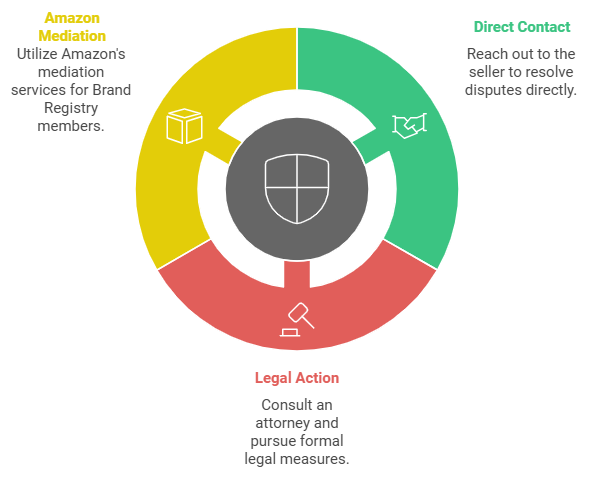Protecting Your Account from Amazon Trademark Infringement Claims
Protecting Your Account from Amazon Trademark Infringement Claims
In the competitive world of Amazon, protecting your brand and products from unauthorized use is essential. One of the best ways to do this is through a trademark. A registered trademark not only protects your brand from counterfeiters but also strengthens your identity, builds customer trust, and enhances your legal standing in case of a suspension or deactivation.
This article explores why trademarks are crucial for Amazon sellers, how to register and enforce them, and the steps to take if a conflict arises.
What is a Trademark ?
A trademark is a legally recognized name, symbol, or logo that distinguishes your goods from others. On Amazon, trademarks protect your brand’s identity and prevent others from using similar names or logos that might confuse customers. This could include your brand name, logo, product name, or even packaging design.
Example: A seller offering handmade leather products under the brand “UrbanLeather” can secure their brand identity with a trademark. This ensures that other sellers cannot use similar names or logos.
Why Trademarks Are Critical ?for Amazon Sellers
1. Access to Amazon Brand Registry
One of the biggest benefits of a trademark is access to Amazon Brand Registry, a platform designed to protect your brand and give you control over your product listings. Brand Registry offers tools to monitor and report counterfeit listings, take ownership of your product pages, and create A+ Content to enhance engagement.
Example: A skincare company that registered their trademark regained control over their listings and swiftly removed counterfeit versions damaging their reputation. Their suspended account was reinstated shortly after defending their brand.
2. Protecting Against Hijackers and Counterfeiters
Without a registered trademark, it’s difficult to stop unauthorized sellers from hijacking your listings. Brand hijackers may list counterfeit products under legitimate brands, causing account suspensions. With Brand Registry, you can quickly report and remove these infringing listings.
Example: A yoga mat seller faced counterfeit versions of their product listed by hijackers. After registering a trademark and enrolling in Brand Registry, they resolved the issue, protecting their brand integrity and preventing suspension.
3. Building Customer Trust and Credibility
Consumers are more likely to trust products that display a registered trademark, as it signals authenticity. On Amazon, where customers face countless choices, a strong, trademarked brand can make the difference between securing a sale or losing it to competitors.
Example: When searching for supplements, customers are more likely to choose a trademarked brand like “PureHealth Organics®” over a generic alternative, confident that it’s legitimate.
How to Register a Trademark for Amazon
The process of trademark registration is straightforward but requires attention to detail. Here’s a quick guide:
1. Choose Your Trademark
Select a unique, identifiable name or logo that represents your brand. Avoid generic or descriptive names, as these are harder to trademark.
2. Conduct a Search
Check that your chosen name or logo isn’t already in use. Use databases like the United States Patent and Trademark Office (USPTO) or international trademark registries.
3. File Your Application
Submit your trademark application with the relevant authority, such as the USPTO or EUIPO. This will require details about your business and how the trademark will be used.
4. Join Amazon Brand Registry
Once approved, enroll in Amazon Brand Registry using your trademark number. This grants access to powerful brand protection tools and boosts your product visibility on Amazon.
Example: An eco-friendly brand, “EcoSip,” registered their trademark through USPTO. After approval, they quickly enrolled in Brand Registry and removed unauthorized sellers from their listings.
Enforcing Your Trademark on Amazon
Once your trademark is registered, enforcing it is essential to protect your brand and prevent suspensions. Here’s how:
1. Monitor Listings Regularly
Keep a close eye on your listings for unauthorized sellers or counterfeiters.
2. Report Violations Immediately
Use Amazon’s “Report a Violation” tool to report suspicious listings. Amazon typically responds quickly, often removing listings within 24-48 hours.
Example: A kitchenware brand noticed counterfeit versions of their products and had them removed within 48 hours of reporting.
3. Keep Detailed Documentation
Maintain thorough records of your trademark registration, product authenticity, and communications with Amazon. This will be vital in case of disputes.
Resolving Trademark Disputes on Amazon
Resolving Trademark Disputes on Amazon
Disputes can arise even with a registered trademark. Here’s how to handle potential conflicts:

Beyond Amazon: Legal Protection for Your Brand
A registered trademark protects your brand beyond Amazon. It grants you the legal right to defend your brand across different platforms and markets, including physical stores.
Example: A fashion brand selling in both retail stores and online discovered a competitor using a similar name. With their registered trademark, they filed a cease-and-desist order to prevent further misuse.
Understanding Temporary Restraining Orders (TROs) in Trademark Disputes
In cases where Amazon sellers are accused of trademark infringement, brand owners may take swift legal actions, such as requesting a Temporary Restraining Order (TRO) to immediately stop sales and freeze funds. A TRO can halt your business operations on Amazon without prior notice, making it essential to understand how TROs work and how to respond effectively. Learn more about TROs and how to protect your business from these urgent legal claims.
Frequently Asked Questions (FAQ) on Amazon Trademark Suspensions
Frequently Asked Questions
Frequently Asked Questions
No, Amazon requires a registered trademark to access Brand Registry.
It can take several months, depending on the jurisdiction. Once approved, you can enroll in Amazon Brand Registry immediately.
Without a trademark, your brand is more vulnerable to counterfeiters and hijackers, and you lose access to Brand Registry tools.
Protect Your Brand Today
Registering a trademark is one of the most effective ways to safeguard your brand on Amazon. It helps prevent unauthorized sellers, protects your reputation, and builds customer trust. If you’re ready to protect your brand, ASA Compliance Group can help you through the process.
Need help with reinstatement At Amazon Sellers Appeal by ASA Compliance Group, led by Or Shamosh, we specializes in resolving trademark suspensions. We’ll guide you through the process to get you back on track fast.

